Star Plants
Colourful plants can be found in all corners of the gardens in all months of the year, just a few of which are highlighted on our plants of the month lists and in our seasonal walks.
In addition there are some plants in the collection that stand out because of their historical association with the gardens, the people that collected them or their botanical interest:
Cedrus deodara (Himalayan cedar)

The view from the terrace is dominated by two fine specimens of the Himalayan cedar planted near the fountain. Distinguished by their fresh green needles on descending branches the seeds of these trees were given to the gardens in the 1840’s by James Watt the younger, then resident at Aston Hall, the son of James Watt the engineer who developed the steam power that drove the industrial revolution.
Dicksonia x lathamii
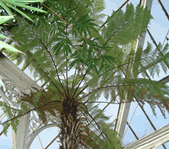 Described in the Gardeners’ Chronicle of 1885 as “this very noble fern which appears to be of hybrid origin, was raised by Mr W. B. Latham, Curator at Birmingham, after whom we have named it”. It is a hybrid between the familiar Dicksonia antarctica found in many gardens and the rare and difficult to cultivate Dicksoina arborescens from the Island of St. Helena. The original plant is unique as far as we know and still grows in our sub-tropical house more than 100 years after the chance hybrid occurred.
Described in the Gardeners’ Chronicle of 1885 as “this very noble fern which appears to be of hybrid origin, was raised by Mr W. B. Latham, Curator at Birmingham, after whom we have named it”. It is a hybrid between the familiar Dicksonia antarctica found in many gardens and the rare and difficult to cultivate Dicksoina arborescens from the Island of St. Helena. The original plant is unique as far as we know and still grows in our sub-tropical house more than 100 years after the chance hybrid occurred.
Davidia involucrata (the handkerchief tree)
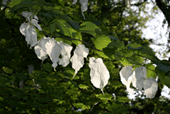 This magnificent tree can be found in the Wilson Walk, and is the highlight of the gardens when in flower in late May and early June. Ernest Henry Wilson studied here in the 1890’s before becoming one of the most successful plant hunters and being re-christened ‘Chinese’ Wilson in recognition of his four long expeditions to China. The seed of this tree was the main object of his first trip to China for the famous Veitch nurseries.
This magnificent tree can be found in the Wilson Walk, and is the highlight of the gardens when in flower in late May and early June. Ernest Henry Wilson studied here in the 1890’s before becoming one of the most successful plant hunters and being re-christened ‘Chinese’ Wilson in recognition of his four long expeditions to China. The seed of this tree was the main object of his first trip to China for the famous Veitch nurseries.
Lilium regale (regal lily)
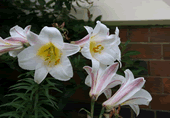 If the handkerchief tree is arguably Wilson’s most famous tree introduction, the regal lily is certainly his most important bulb. It is beautiful, reasonably easy to grow and will flower in two years from seed. It took two attempts to successfully introduce it to cultivation and nearly cost Wilson his life after he was caught in an avalanche and severely injured. He acquired the lily and an injured leg that gave him his characteristic ‘lily limp’. Drifts of the lily can be found in the Alpine yard, Pinetum and cottage gardens.
If the handkerchief tree is arguably Wilson’s most famous tree introduction, the regal lily is certainly his most important bulb. It is beautiful, reasonably easy to grow and will flower in two years from seed. It took two attempts to successfully introduce it to cultivation and nearly cost Wilson his life after he was caught in an avalanche and severely injured. He acquired the lily and an injured leg that gave him his characteristic ‘lily limp’. Drifts of the lily can be found in the Alpine yard, Pinetum and cottage gardens.
Camellia sinensis (tea)
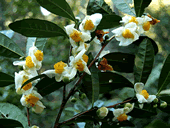 Camellia sinensis. It is not a particularly showy plant, nor quite hardy in the British Isles, we grow it in our sub-tropical house. Many of the plants in our heated houses are grown to show visitors and school groups these economic plants that we all depend on. If you take sugar with your tea you will also find sugar cane in the sub-tropical house, other economic plants are explained in our product pods.
Camellia sinensis. It is not a particularly showy plant, nor quite hardy in the British Isles, we grow it in our sub-tropical house. Many of the plants in our heated houses are grown to show visitors and school groups these economic plants that we all depend on. If you take sugar with your tea you will also find sugar cane in the sub-tropical house, other economic plants are explained in our product pods.
Wollemia nobilis (Wollemi pine)
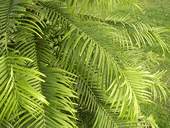 Once in a while a spectacular find is made, a tree new to science from the age of the dinosaurs. In 1994 in a canyon just north of Sydney in Australia a few specimens of a conifer closely related to the monkey puzzle were discovered. Wollemia nobilis is named after the park where it was discovered. Since 1994 less than 100 have been found in the wild in locations that are closely guarded secrets. They are now available commercially, the money goes towards safeguarding the wild populations. We planted a specimen on the West Lawn to mark our 175th anniversary in 2007. Similar fossil trees can be found at the gardens including the dawn redwood (Metasequoia glyptostroboides) and the maidenhair tree (Ginkgo biloba).
Once in a while a spectacular find is made, a tree new to science from the age of the dinosaurs. In 1994 in a canyon just north of Sydney in Australia a few specimens of a conifer closely related to the monkey puzzle were discovered. Wollemia nobilis is named after the park where it was discovered. Since 1994 less than 100 have been found in the wild in locations that are closely guarded secrets. They are now available commercially, the money goes towards safeguarding the wild populations. We planted a specimen on the West Lawn to mark our 175th anniversary in 2007. Similar fossil trees can be found at the gardens including the dawn redwood (Metasequoia glyptostroboides) and the maidenhair tree (Ginkgo biloba).

